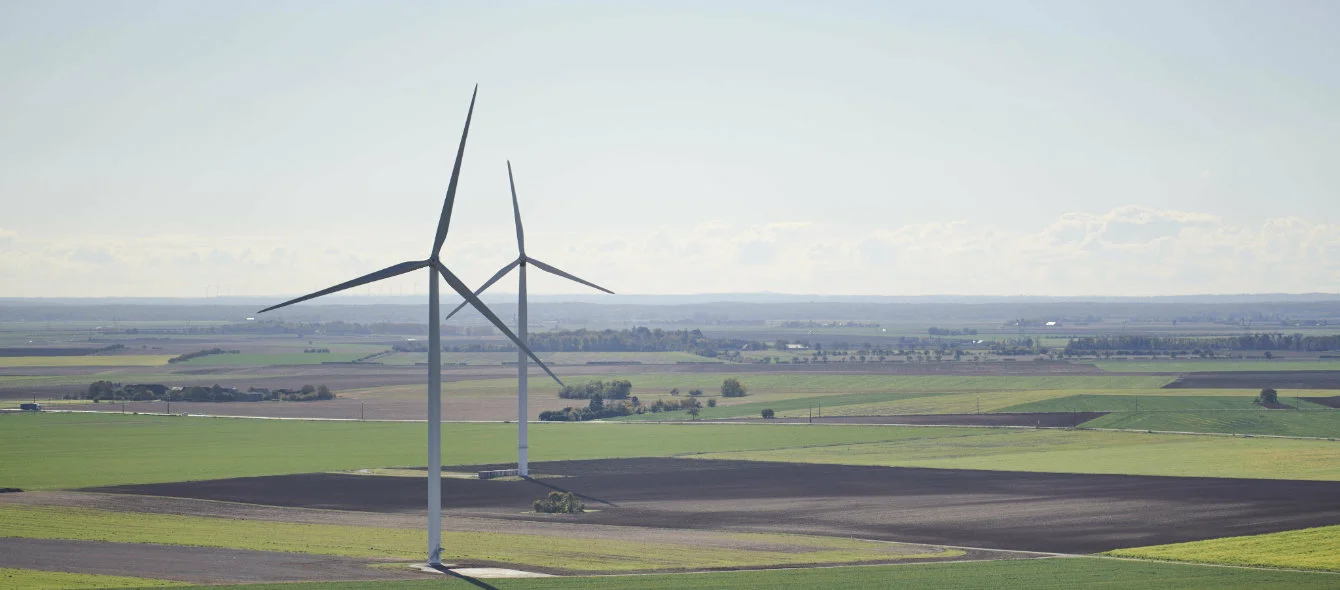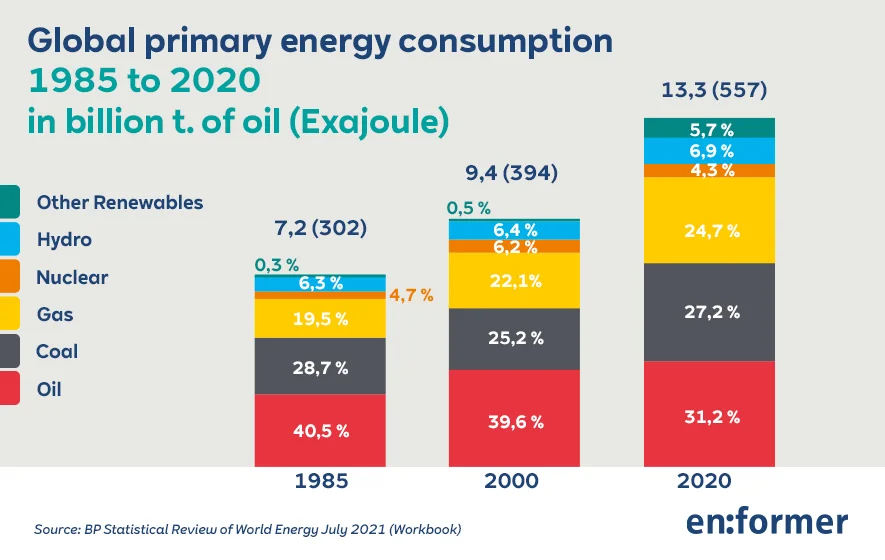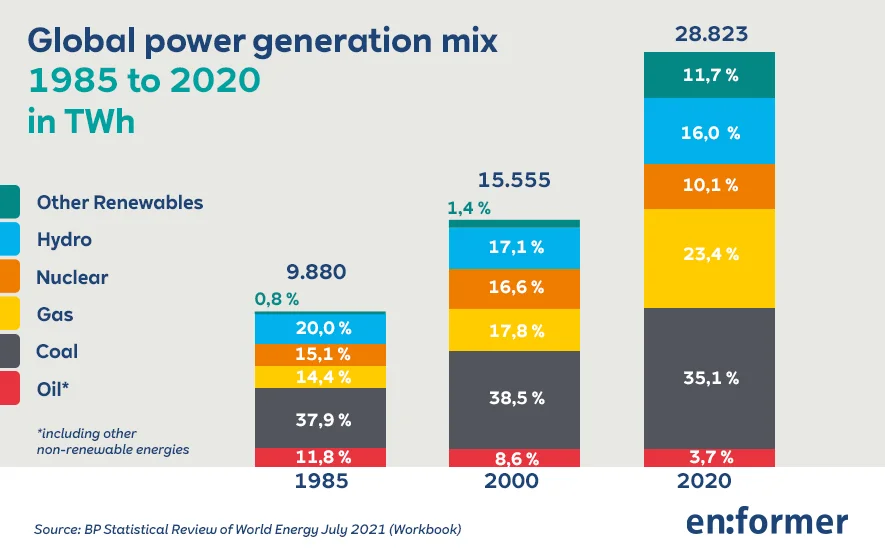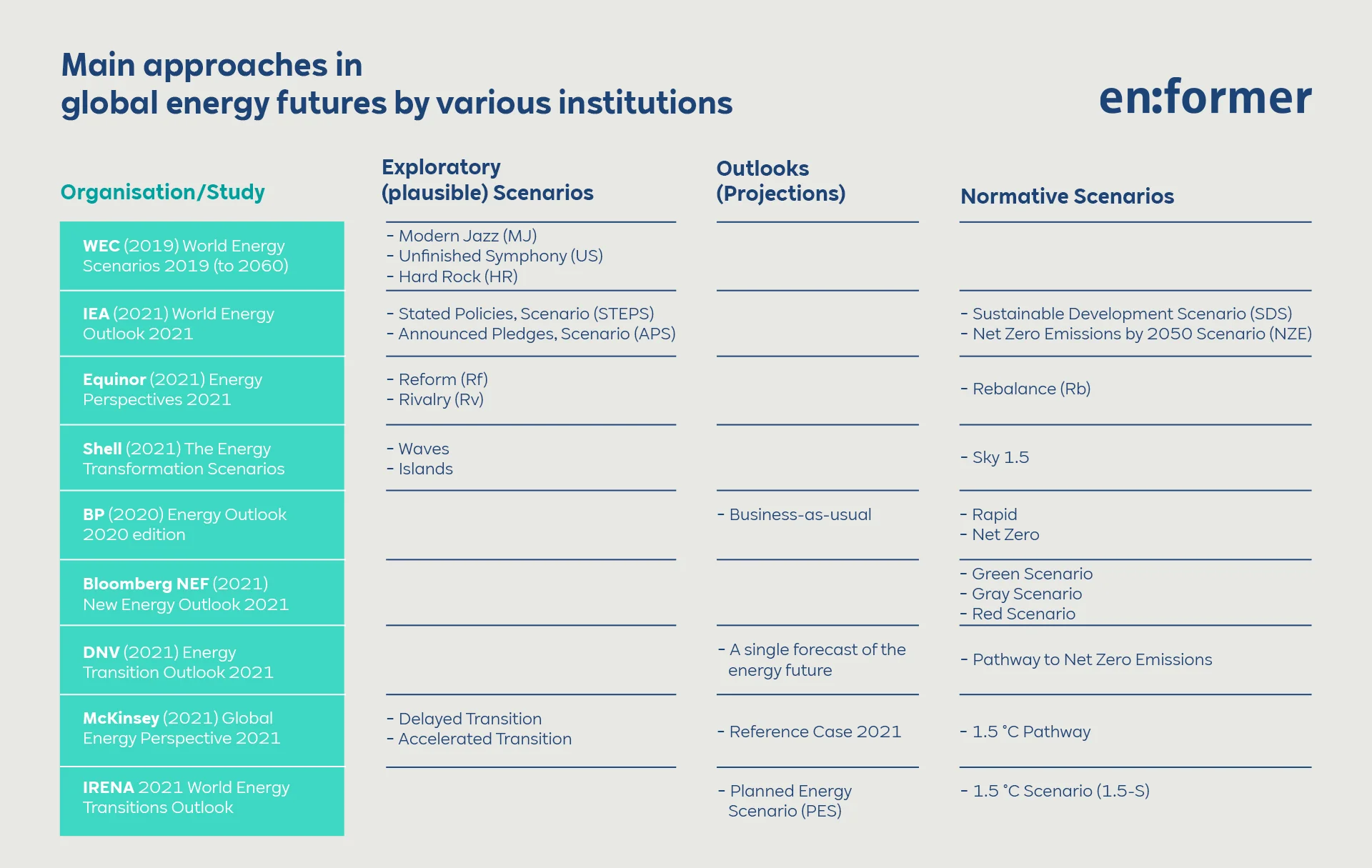Author: H.-W. Schiffer
In a guest article, Dr. Hans-Wilhelm Schiffer discusses the characteristics of forecasts and scenarios for the energy transition in various studies. In doing so, he critically classifies the approaches pursued by the institutions mentioned. Originally, the article appeared in 2021 under the title “Forecasts and scenarios for global energy supply as the basis for climate policy implications” in the magazine VGB PowerTech. This is the first part of the series of articles.
Various institutions regularly publish studies on the prospects for global energy supply. These include international organizations such as the International Energy Agency (IEA), the International Renewable Energy Agency (IRENA) and the World Energy Council (WEC), consulting firms such as DNV, BloombergNEF and McKinsey & Company, as well as energy groups such as BP, Shell and Equinor.
Professor Dr. Hans-Wilhelm Schiffer
Lecturer at RWTH Aachen University, Member of the Studies Committee, World Energy Council, London and Chairman of the Energy for Germany editorial group at the Weltenergierat – Deutschland, Berlin
In order to be able to compare and to highlight similarities and differences, the respective underlying methodological approaches and the assumptions made are of particular relevance. This article outlines the characteristics of projections as well as exploratory and normative scenarios, and classifies the approaches pursued by the institutions mentioned.
The key messages conveyed in the studies are presented against the background of developments over the past decades. Increasing electrification and increased use of hydrogen are identified as decisive factors in achieving the pursued climate goals. Finally, it is assessed to what extent the reported results align with the Glasgow Climate Pact and what consequences result from it.
Development of the global energy supply from 1985 to 2020
A presentation of the results of the projections and scenarios, in which statements about the coming 30 years are made, shall be preceded by the essential characteristics of the global development of energy supply and demand in the period 1985 to 2020. First, the primary energy consumption.
From 1985 to 2020, global energy consumption almost doubled. The main drivers of this development were a population increase by 60 percent and the increase in global economic output by 174 percent. The energy mix has changed within these 35 years:
- The increase in energy consumption was almost entirely covered by fossil fuels. All fossil fuels made growing contributions to covering rising demand.
- In 2020, the share of fossil energies in primary energy consumption was only 5.6 percentage points lower than in 1985. In 2020, 83.1 percent of total energy consumption was accounted for by coal, crude oil and natural gas. In 1985 it was 88.7 percent.
- The share of nuclear energy decreased from 4.7 percent to 4.3 percent.
- The contribution from renewable energies almost doubled from 6.6 percent to 12.6 percent.
Global electricity generation almost tripled between 1985 and 2020. Here, too, a comparable picture emerges with regard for the role of fossil fuels.
The growth in electricity generation was based largely on a significantly increased use of coal and natural gas.
- The share of fossil fuels in electricity generation hardly decreased – from 64.1 percent in 1985 to 62.2 percent in 2020.
- The relative contribution of nuclear energy was reduced from 15.1 percent to 10.1 percent.
- With a share gain of 6.9 percentage points, renewable energies were able to compensate for the relative losses of nuclear and fossil energies. Hydropower, wind and solar energy as well as biomass and geothermal energy accounted for 27.7 percent of global electricity generation in 2020 compared to 20.8 percent in 1985.
The decades ahead will be fundamentally different from the development shown for the past.
Categorization of projections and scenarios
Basically, a distinction can be made between exploratory scenarios, projections and normative scenarios.
Exploratory scenarios are plausible, comprehensible, alternative views of the future that show conceivable results and help to understand how different factors can interact and thus shape the future. They address critical uncertainties, but also foreseeable trends and show the effects of assumptions made about the future. They are not predictions. Probabilities of occurrence are not assigned to exploratory scenarios. The focus is on a narrative that is quantitatively underpinned with model support. Exploratory scenarios provide a basis for a successful strategy and policy in a world marked by uncertainty.
Future developments are presented in projections rooted in parameters assumed to be likely, including the development of demographics, economic performance, technological innovations, world market prices for energy and expected political frameworks. Projections therefore aim to depict the development that is believed to be probable in the sense of a forecast. The focus is on the model-based achievement of quantitative results.
Normative scenarios have a completely different character. The starting point is a clearly defined goal or set of goals for the future. From this starting point, a technically possible path is determined in order to achieve the desired goal under conditions that are as economically feasible as possible. For example, the goal may be to limit the rise in global temperature to a maximum of 1.5 degrees Celsius compared to pre-industrial levels.
When comparing the results of different studies, it is therefore of crucial importance which approach was followed in each case. The scenarios and projections presented by the institutions mentioned above in 2021 are assigned to the individual categories.
Results of different projections in comparison
Projections for global energy supply have been published in the last few months mainly by the Norwegian consulting and certification group DNV and McKinsey. The main results for the time horizon up to 2050 are as follows:
In contrast to the past, primary energy consumption will practically no longer increase in the future, but will – despite a further increase in the population and continued growth in economic output – remain at the current level. The energy consumption per capita of the population is therefore falling significantly.
A second statement – also deviating from the trends of the past – according to DNV: Fossil fuels are increasingly being replaced by renewable energies. The share of oil, natural gas and coal in primary energy consumption will decrease from currently more than 80 percent to 50 percent by 2050 .
The growth of renewable energies is mainly generated by wind power and solar energy. In contrast, hydropower, biomass and geothermal energy can only achieve limited growth. Both DNV, and McKinsey, among others agree with this tendency.
Importance of fossil energies is decreasing
Still fossil energies will remain important in the future. However, their importance is clearly decreasing. This is especially true for coal. Global consumption of coal, which has risen sharply since 2000 due to the increasing use of this energy source, especially in China, reached its peak in 2014 according to the assessment of most of the available studies. Peak oil demand is expected towards the end of the 2020s.
While the demand for natural gas, a further increase is initially expected. This applies well into the 2030s. According to McKinsey, the highest global demand for natural gas will be reached in the second half of the 2030s, before a steady decline sets in.
Global electricity demand will triple
In contrast to primary energy consumption, demand for electricity is expected to continue growing. According to the projections available, the upward trend will even accelerate in the coming decades. By 2050, this will almost triple the global demand for electricity compared to the level in 2020.
The move away from fossil fuels to renewables is more notable in the electricity supply than is reflected in the figures for primary energy consumption.
In 2020, coal was the world’s most important energy source for electricity generation with a share of 35 percent. This has not changed in 2021 either.
By the middle of the current decade, however, renewable energies are ousting coal from this position. Natural gas can continue to play its role as the second most important energy source for generating electricity for the foreseeable future, alternating with coal, which will drop to third place in the 2030s.
Unlike in the transport sector and the heating market, oil does not play a significant role in power generation. The contribution of nuclear energy to the generation of electricity remains constant at a global average of 10 percent. Among the renewable energies, wind and solar energy achieve by far the largest increases.
Hydrogen will have a key role
In addition to increased electrification, hydrogen will play a key role in the upcoming transformation of the energy supply. For example, DNV predicts that global demand for hydrogen will increase six-fold by 2050 compared to today’s level. In industry in particular, hydrogen is increasingly being used in order to implement the necessary decarbonization in the sector particularly in the chemistry and steel industries. In addition, increasing importance is attributed to hydrogen, especially in the areas of the transport sector that are difficult or impossible to electrify. These are aviation, shipping and heavy haulage.
The production of hydrogen is possible on the basis of fossil energies as well as using electricity from nuclear power plants as well as from renewable energies. However, hydrogen can only make a contribution to climate protection if its generation is largely CO2-free. This is just as possible by means of electrolysis using electricity from renewable energies as using electricity from nuclear power plants.
Using natural gas or coal to produce hydrogen is only advantageous from the point of view of climate protection if the CO2 is captured in the process and used or stored (CCUS).
Classification of hydrogen
Depending on the energy source used, the hydrogen is classified with different colors. The color gray stands for hydrogen, produced from fossil fuels without the separation and storage of CO2. Hydrogen based on natural gas with CCUS has the color blue. Hydrogen is considered green if the product was produced using electricity from renewable energies. While the generation of hydrogen based on fossil fuels, in particular natural gas, dominates now, the expected increases are to be made available primarily through electricity from wind and solar systems.
Photo credit: © RWE AG, Stephane Adam



